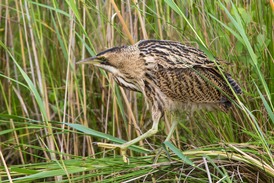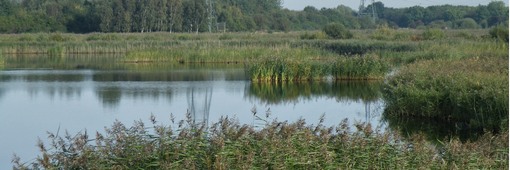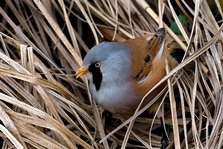

Biodiversity
Action
Plan
The fringes of Reedbeds, often extending into areas of Reed Canary Grass, are important for Grass Snake which uses rotting leaf-litter for to incubate its eggs. Reed Canary Grass, preferring slightly drier conditions, may provide a corridor habitat along the edges of ditches and dikes where Harvest Mouse in particular may flourish.
Grasshopper Warbler and Cetti’s Warbler nest in drier mixed areas with associated carr scrub.
The ideal for supporting varied wildlife is to have all the stages of succession from young reed in shallow water to old reed with scrub invasion on almost dry ground over dense litter. This requires regular management of mature reedbed by cutting reeds in rotation, one cell or compartment each year.
The mown area is good for Snipe, Redshank and Mallard; the dense wet reedbed with little litter and high seed production supports Bittern, Marsh Harrier, and Reed Warbler; old reed with a dense litter layer benefits Bearded Tit, Sedge Warbler and Marsh Harrier;
A good number of species, for example Otter and Marsh Harrier, need links with other habitats including wet grassland and carr woodland.
Bittern, Marsh Harrier and Bearded Tit are said to require reed beds 20ha in size. Locally however smaller reedbeds have supported these species. Other species are supported by much smaller areas of reedbed as well as by other swamp, fen and marsh habitats.
Features of Reedbed and fen habitats
Reedbed and fen habitat is beneficial to the greatest number of species when it includes a range of features.

Species supported in Barnsley by reedbeds and wetland habitat
Birds: Bittern has bred in the RSPB Old Moor reedbeds from 2010, with two to three pairs each year, and Marsh harrier bred for the first time in 2020.
Bearded Tits started breeding in 2017.
Maintaining open water with pools and channels within the reedbed, promotes marginal plants as well as dragon and damselflies and other invertebrates.
The reedbed edges with open water also enable a range of birds, including Bittern, to forage.

Reedbed and Fen Features

Cetti’s warbler has also bred, joining more common breeding birds including Reed and Sedge Warblers.
Reedbeds provide roosting sites for migratory species like Swallow, and for several raptor species in winter. Starlings also roost in the reedbeds in winter months, performing their spectacular mumurations.
Amphibians: Great Crested Newt, other newts, Common Frog, Common Toad all benefit from reedbed and fen habitats.
Reptile: Grass snake
Mammals: Reedbeds are also important for Water voles as well as Harvest Mouse, some bats and Otter
Invertebrates: Several Red Data Book invertebrates are also closely associated with reed-beds including damsel and dragonflies and moths like the locally rare Fen Wainscot Moth.